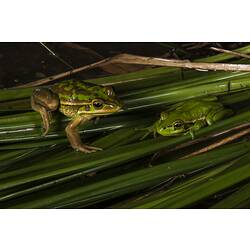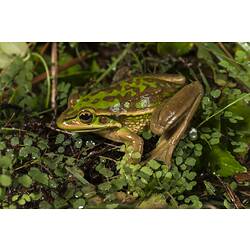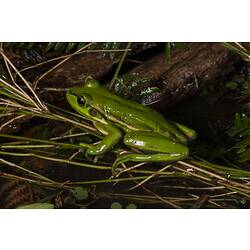General Description
Body dark or light green with golden or brown patches and a pale brown stripe along the side of the body. groin and back of the thighs are a bright turquoise blue colour. The belly is white and granular and the back is smooth. Pads are present on the fingers and toes, but only slightly wider than them. Fingers are unwebbed, toes are webbed. Body size up to 8.5 cm. Call slow and made up of four parts; "craw-awk, crawk, crok, crok".
Biology
Green and Golden Bell Frogs are cannibalistic, eating other frogs. Individuals shelter in vegetation, but will move about during the day and often bask during the day. Peak calling occurs from November to January. They also start calling on cloudy, humid days. Sadly, this species has suffered severe population declines in recent years, most noticeably in New South Wales.
Distribution
South-western and south-eastern mainland Australia and Tasmania.
Habitat
Wet forest, woodland and shrubland areas, preferring areas on the edge of rivers and swamps.
More Information
-
Animal Type
-
Animal SubType
-
Brief Id
Large ground-dwelling green and golden frog with smooth back and distinctive calling sound.
-
Colours
Green, Brown, White
-
Maximum Size
8.5 cm
-
Habitats
-
Diet
Carnivore
-
Diet Categories
Insects, Frogs
-
Endemicity
-
Commercial
No
-
Conservation Statuses
CITES: Not listed, FFG Threatened List: Not listed, EPBC Act 1999: Vulnerable, IUCN Red List: Vulnerable
-
Taxon Name
-
Scientific Author
(Lesson, 1829)
-
Common Name
Green and Golden Bell Frog
-
Other Names
Green and Golden Grass Frog
-
Kingdom
-
Phylum
-
Subphylum
-
Class
-
Subclass
-
Order
-
Family
-
Genus
-
Species Name
aurea




















